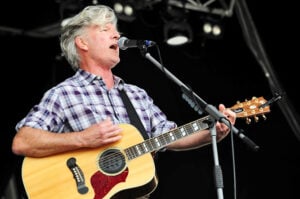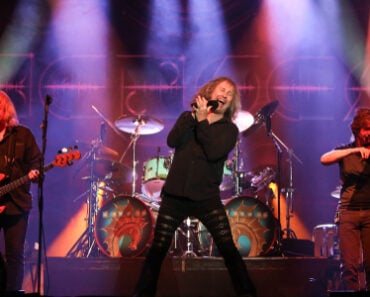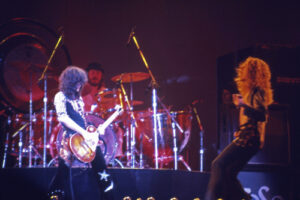
Feature Photo: Stuart Sevastos, CC BY 2.0 <https://creativecommons.org/licenses/by/2.0>, via Wikimedia Commons
From Melbourne rehearsal rooms to international stages across four decades, Crowded House emerged as one of Australasia’s most enduring musical exports. The band formed in Melbourne, Victoria, Australia, in 1985, initially as “The Mullanes” before adopting the name that would define their legacy. Originally active from 1985 to 1996, Crowded House had consistent commercial and critical success in Australia and New Zealand and achieved significant international recognition with multiple chart-topping albums.
Crowded House have sold over 15 million albums worldwide and released eight studio albums spanning nearly four decades. The band experienced several hiatuses and reformations, with significant periods of activity from 1985-1996, 2007-2011, and 2016 onwards with their current lineup. In November 2016, the band was inducted into the ARIA Hall of Fame, recognizing their substantial contribution to Australian and New Zealand music. Their chart success includes number one albums in Australia and New Zealand, Top 10 hits in the United States with “Don’t Dream It’s Over” and “Something So Strong,” and significant success in the UK and European markets during the 1990s.
The band has undergone multiple lineup changes throughout their history, with only Neil Finn and Nick Seymour serving as consistent members across all active periods. Their most recent album, Gravity Stairs, was released in 2024 with their current formation featuring Neil Finn, Nick Seymour, Mitchell Froom, and Finn’s sons Liam and Elroy. The group’s legacy includes thirteen ARIA Awards, an MTV Video Music Award, and a BRIT Award, cementing their position as one of the most successful bands to emerge from the Southern Hemisphere.
Neil Finn
Neil Finn served as the primary songwriter, lead vocalist, and guitarist for Crowded House throughout the band’s entire history from 1985 to present. Born in Te Awamutu, New Zealand, Neil joined his older brother Tim’s band Split Enz at age 19 and contributed the group’s biggest international hit “I Got You” in 1980. When Split Enz disbanded in 1984, Neil partnered with drummer Paul Hester to create what would become Crowded House. As the band’s creative driving force, Neil has been responsible for writing the majority of Crowded House’s material across all eight studio albums.
Neil’s contributions span all studio albums from the self-titled 1986 debut through 2024’s “Gravity Stairs.” His songwriting combines intricate melodies with impressionistic lyrics, creating the distinctive sound that defines Crowded House. Beyond the band’s commercial hits like “Don’t Dream It’s Over” and “Weather with You,” Neil’s catalog includes deeper album tracks that showcase his range as a composer. His guitar work ranges from acoustic fingerpicking to electric arrangements, while his keyboard contributions add textural elements to many recordings.
Outside Crowded House, Neil has maintained an active solo career with albums including “Try Whistling This” (1998), “One Nil” (2001), and “Dizzy Heights” (2014). He collaborated extensively with his brother Tim in the Finn Brothers project, releasing two albums in 1995 and 2004. Most notably, Neil joined Fleetwood Mac as a full-time member in 2018, touring globally with the legendary group before returning focus to Crowded House. His work earned him an Officer of the Order of British Empire (OBE) in 1993 for services to New Zealand music. Neil continues to lead Crowded House in their current incarnation while maintaining various side projects and collaborations.
Nick Seymour
Nick Seymour approached Neil Finn during Split Enz’s farewell tour and became a founding member of Crowded House in 1985. The Australian bassist remains the only other constant member alongside Neil Finn throughout the band’s history across all periods of activity. Nick’s bass playing provides the rhythmic foundation for Crowded House’s sound, complementing Neil’s songwriting with both melodic bass lines and solid rhythmic support that has remained consistent across nearly four decades.
Nick appeared on all Crowded House studio albums from their 1986 debut through “Gravity Stairs” in 2024. His bass work evolved from the straightforward rock approaches of early albums to more sophisticated arrangements on later releases. Beyond bass, Nick contributed backing vocals and occasional keyboards to various recordings throughout the band’s catalog. His playing style combines technical proficiency with an understanding of how bass can serve the song rather than dominating it, creating space for Neil’s vocals and guitar work.
During Crowded House’s initial hiatus after 1996, Nick pursued various projects including the band Deadstar with former Crowded House drummer Peter Jones, releasing the album “Milk” in 1997. When Paul Hester died in 2005, Nick’s reunion with Neil Finn helped catalyze Crowded House’s reformation for “Time on Earth.” Nick has remained committed to the band through multiple lineup changes and continues as a core member in their current configuration. His brother Mark Seymour fronted the successful Australian band Hunters and Collectors, making music a family affair in the Australian rock scene.
Paul Hester
Paul Newell Hester was born in Melbourne on January 8, 1959, to a bushman father and jazz drummer mother who encouraged his early musical development. He served as Crowded House’s drummer from the band’s formation in 1985 until his departure in 1994. Before Crowded House, Paul was the drummer for Split Enz from November 1983 until their breakup in December 1984, where he first worked with Neil Finn. His transition from Split Enz to Crowded House represented a continuation of his musical partnership with Neil.
Paul’s drumming appeared on Crowded House’s first four studio albums: the self-titled debut (1986), “Temple of Low Men” (1988), “Woodface” (1991), and “Together Alone” (1993). His style combined technical skill with musical sensitivity, providing both powerful rhythmic drive and subtle textural elements that became integral to the band’s sound. Beyond drumming, Paul contributed backing and occasionally lead vocals, keyboards, and percussion to various recordings. His personality brought humor and energy to the band’s live performances, making him a beloved figure among fans and fellow musicians.
Paul quit Crowded House during a US tour on April 15, 1994, flying home to Melbourne to await the birth of his first child and citing the need for more family time. After leaving the band, Paul appeared regularly on Australian television and radio, including the popular radio show Martin/Molloy from 1995-1998. He formed bands including Largest Living Things and Tarmac Adam, worked as a session musician, and hosted his own television show “Hessie’s Shed.” Tragically, Paul Hester died by suicide on March 26, 2005, in Melbourne after struggling with depression. His death deeply affected the music community and ultimately led to Neil Finn and Nick Seymour’s reunion for “Time on Earth,” which was dedicated to his memory.
Tim Finn
Tim Finn founded Split Enz in 1972 with Phil Judd and served as the band’s primary songwriter and lead vocalist before his younger brother Neil joined the group. His involvement with Crowded House began in early 1990 when he started collaborating with Neil on material intended for a Finn Brothers album. When Neil proposed incorporating these songs into the next Crowded House album, Tim agreed and became a full member of the band for the “Woodface” period from 1990-1991.
Tim co-wrote the majority of songs on “Woodface,” including the international hits “Four Seasons in One Day,” “Weather with You,” and “It’s Only Natural.” His contributions to the album included lead and backing vocals, keyboards, and guitar work alongside his songwriting partnership with Neil. The collaboration between the Finn brothers created some of Crowded House’s most enduring and commercially successful material. Tim also provided session contributions to earlier albums, including work on “Temple of Low Men” (1988) and later appeared as a guest on “Together Alone” (1993).
Tim left Crowded House during the “Woodface” tour in November 1991, partway through the UK leg, with his departure attributed to the challenges of working in a band led by his younger brother and creative differences over musical direction. Outside Crowded House, Tim maintained a successful solo career with albums including “Escapade” (1983), “Big Canoe” (1986), and numerous releases through the 2000s and 2010s. He collaborated with Neil on two Finn Brothers albums in 1995 and 2004. In June 1993, both Neil and Tim Finn were awarded Officers of the Order of British Empire (OBE) for their contributions to New Zealand music. Tim continues performing and recording, including recent collaborations with former Split Enz members in projects like Forenzics with Eddie Rayner.
Mark Hart
Mark Hart was born on July 2, 1953, in Fort Scott, Kansas, and became known as a multi-instrumentalist through his work with both Supertramp and Crowded House. He began piano lessons at age seven and later learned guitar, studying classical music at college before working as a session musician and forming the band Combonation in 1982. His connection to Crowded House began when the band needed a replacement for touring keyboardist Eddie Rayner, with manager Gary Stamler recommending Mark based on his work with Combonation.
Mark initially joined Crowded House as a touring musician in January 1989, replacing Eddie Rayner who had left due to family commitments. He became a full band member in 1993 for “Together Alone” and contributed to “Woodface” (1991), “Together Alone” (1993), “Time on Earth” (2007), and “Intriguer” (2010). His multi-instrumental abilities included guitar, keyboards, lap steel, backing vocals, and various other instruments that significantly expanded Crowded House’s sonic palette. His arrangements and musical contributions were particularly notable on “Together Alone,” where his guitar work and keyboard arrangements helped create the album’s expansive sound.
Mark participated in Crowded House’s farewell concert at the Sydney Opera House in November 1996 and remained with the band through their 2007-2011 reunion period. During the band’s hiatus periods, Mark rejoined Supertramp from 1996-2002 and toured with Ringo Starr’s All-Starr Band. When Crowded House announced their 2020 reunion, Mark was not included in the new lineup, with Neil Finn choosing to work with Mitchell Froom and his sons instead. Outside his band commitments, Mark has worked as a producer, film composer, and session musician for numerous artists including Ringo Starr, Chrissie Hynde, and Peter Case. He released a solo album “Nada Sonata” in 2002 and continues his work in music production and composition.
Craig Hooper
Craig Hooper was a founding member of Crowded House during their earliest formation as “The Mullanes” in 1985. He came to the band from The Reels and served as guitarist during the group’s initial developmental period in Melbourne. His time with the band was brief, lasting only during the formation period before the group secured their record contract and began their professional recording career.
Craig’s departure occurred when the band moved to Los Angeles to work with Capitol Records, at which point the group consisted of Neil Finn, Paul Hester, and Nick Seymour. His exit happened before any recording sessions took place, meaning he did not appear on any Crowded House albums or official releases. His contributions were limited to the early developmental stage of the band’s sound and songwriting process during rehearsals and early live performances in Melbourne.
Craig’s involvement represents the transitional period between the end of Split Enz and the formation of the classic Crowded House lineup. While his musical contributions to Crowded House’s recorded legacy are minimal, he was part of the formative process that helped establish the band’s early direction and sound. After leaving The Mullanes/Crowded House, Craig continued his musical career, though detailed information about his subsequent projects and activities remains limited in available documentation.
Peter Jones
Peter Jones joined Crowded House as drummer in 1994 following Paul Hester’s departure during the “Together Alone” tour. His tenure with the band spanned from 1994-1996 during the final period of Crowded House’s initial run, making him the drummer during their farewell period. He was 49 years old when he died from brain cancer on May 18, 2012, with the band describing him as “a warm-hearted, funny and talented man, who was a valuable member of Crowded House.”
Peter’s primary contributions to Crowded House were through live performances during the band’s touring commitments in support of “Together Alone.” While his recorded contributions were limited, he played drums on “Help is Coming” and “Anthem,” which were recorded during 1995 demo sessions but not released until much later as charity singles. His most notable public appearance with the band was during their farewell concert at the Sydney Opera House in November 1996, where he made a guest appearance alongside the returning Paul Hester.
During Crowded House’s hiatus following 1996, Peter collaborated with Nick Seymour in the Australian band Deadstar, contributing to their album “Milk” in 1997. This project allowed him to continue working with Crowded House members while the main band remained inactive. Peter’s contributions to Crowded House were significant during a transitional period, helping maintain the band’s touring schedule and live performances during their final years before the extended hiatus. His drumming style supported the band’s established sound while bringing his own musical sensibilities to their live performances during a crucial period in the band’s history.
Matt Sherrod
Matthew Jackson “Matt” Sherrod was born on July 11, 1968, and raised in Southern California, beginning drums at age nine and piano at age twelve. He became widely known as the drummer for rock artist Beck before joining Crowded House during their 2007 reunion. His selection came after an extensive audition process following Paul Hester’s death in 2005, with Neil Finn choosing Matt partly because his relative unfamiliarity with Crowded House’s history would bring fresh energy to the band.
Matt’s drumming appeared on “Time on Earth” (2007) and “Intriguer” (2010), both of which reached number one in Australia, marking successful commercial returns for the reformed band. His approach brought technical proficiency and contemporary sensibilities while respecting the band’s established sound and musical traditions. The reformation period with Matt represented Crowded House’s ability to continue creating relevant music while honoring their legacy, with both albums receiving critical acclaim and commercial success.
Beyond his work with Beck and Crowded House, Matt has contributed to recordings with various artists including NOFX, Macy Gray, Seiko Matsuda, and Donna De Lory. He collaborated with his brother Paul Sherrod on music for Tracie Spencer and participated in Beck’s metal band project Wounded Cougar. Matt was not included in Crowded House’s 2020 reformation, with Neil Finn choosing to work with Mitchell Froom and his sons Liam and Elroy instead. As an ambidextrous musician, Matt performs some tasks with his left hand and some with his right, though he plays drums left-handed. His work on the 1991 Follow for Now album showcased his versatility, playing drums on eleven of twelve tracks and co-producing the release with his brother.
Mitchell Froom
Mitchell Froom originally served as producer on Crowded House’s first three albums before becoming a full band member in 2020. Born in Canada, Mitchell established himself as one of the music industry’s most respected producers, working on over 75 albums since 1985 with artists including Bonnie Raitt, Sheryl Crow, Elvis Costello, Los Lobos, and the Corrs. His production work has earned him nominations for two Grammy Awards, an Emmy, and a Golden Globe, establishing his credentials as a top-tier music producer.
Mitchell’s production work shaped the distinctive sound of “Crowded House” (1986), “Temple of Low Men” (1988), and “Woodface” (1991), creating the sonic foundation that defined the band’s classic period. His production style emphasizes organic instrumentation combined with subtle electronic elements, creating the spacious yet intimate sound that became Crowded House’s signature. His understanding of Neil Finn’s songwriting and the band’s musical dynamics made him an integral part of their creative process during their most successful period.
As a current member of Crowded House since 2020, Mitchell contributes keyboards, arrangements, and his extensive production expertise to “Dreamers Are Waiting” (2021) and “Gravity Stairs” (2024). His transition from behind-the-scenes producer to frontline performer represents a unique evolution, with Neil Finn noting that Mitchell sometimes still tries to organize things like a producer during rehearsals. Outside his Crowded House work, Mitchell has maintained his production career and released solo material, including his album “Dopamine” featuring collaborations with artists like Suzanne Vega (his wife), Soul Coughing’s M. Doughty, and Sheryl Crow.
Liam Finn
Liam Finn officially joined Crowded House as a full member in 2020, though he had previously served as a touring member during 2007-2008. As Neil Finn’s eldest son, his involvement represents a generational continuation of the Crowded House legacy while bringing contemporary influences to the band’s sound. His multi-instrumental abilities include guitar, drums, backing and lead vocals, allowing him to contribute across various musical elements within the band’s arrangements.
Liam’s contributions appear on “Time on Earth” (2007), “Intriguer” (2010), “Dreamers Are Waiting” (2021), and “Gravity Stairs” (2024). According to Neil Finn, both Liam and his brother Elroy are accomplished writers, expanding the band’s creative dimensions and allowing them to explore new musical territories. His songwriting contributions add a fresh perspective to Crowded House’s creative process while maintaining connection to the band’s established musical traditions.
Outside Crowded House, Liam has maintained a successful solo career beginning with acclaimed albums starting in 2007. His solo work demonstrates his ability to craft intricate pop songs with experimental elements, influenced by his father’s approach but establishing his own distinct artistic identity. Albums like “I’ll Be Lightning” and “FOMO” showcase his talents as both a songwriter and multi-instrumentalist. Liam’s dual role as both a Finn family member and accomplished independent musician adds complexity to Crowded House’s current dynamic, bringing both familial understanding and professional expertise to the band’s evolution.
Elroy Finn
Elroy Finn became a full member of Crowded House in 2020 after serving as a touring member in 2008 and 2016. As Neil Finn’s younger son, he represents the band’s future direction while maintaining connections to their musical heritage. His primary role is drummer, though he also contributes backing vocals, guitars, and keyboards to the band’s arrangements, demonstrating the multi-instrumental approach that has become characteristic of Crowded House members.
Elroy’s drumming appears on “Time on Earth” (2007), “Dreamers Are Waiting” (2021), and “Gravity Stairs” (2024). His approach to drumming balances respect for Crowded House’s established rhythmic foundations, particularly the legacy of Paul Hester’s style, with contemporary influences and techniques. Neil Finn has praised both his sons as accomplished writers, noting that their contributions along with Mitchell Froom’s arrangement skills have expanded the band’s creative universe.
As the youngest member of Crowded House, Elroy brings generational perspective to the band while respecting its musical traditions. His multi-instrumental capabilities allow him to contribute beyond traditional drumming roles, adding texture and depth to the band’s current sound through guitar work and vocal harmonies. Elroy has also pursued independent musical projects, demonstrating his artistic development alongside his contributions to the family band. His presence creates an interesting dynamic of established musical traditions combined with fresh contemporary perspectives, helping ensure Crowded House’s continued relevance and evolution.
Check out similar Crowded House articles on ClassicRockHistory.com Just click on any of the links below……
Top 10 Crowded House Songs
Complete List Of Crowded House Albums And Discography
Read More: Artists’ Interviews Directory At ClassicRockHistory.com
Read More: Classic Rock Bands List And Directory



































